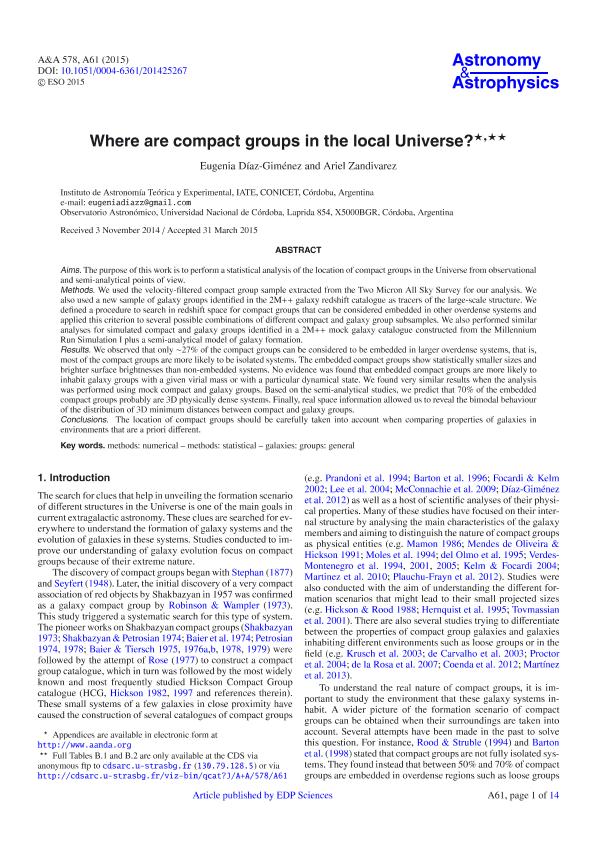Mostrar el registro sencillo del ítem
dc.contributor.author
Diaz, Maria Eugenia

dc.contributor.author
Zandivarez, Arnaldo Ariel

dc.date.available
2019-02-05T14:55:34Z
dc.date.issued
2015-06
dc.identifier.citation
Diaz, Maria Eugenia; Zandivarez, Arnaldo Ariel; Where are compact groups in the local Universe?; EDP Sciences; Astronomy and Astrophysics; 578; 6-2015; 61-75
dc.identifier.issn
0004-6361
dc.identifier.uri
http://hdl.handle.net/11336/69390
dc.description.abstract
The purpose of this work is to perform a statistical analysis of the location of compact groups in the Universe from observational and semi-analytical points of view. Methods. We used the velocity-filtered compact group sample extracted from the Two Micron All Sky Survey for our analysis. We also used a new sample of galaxy groups identified in the 2M++ galaxy redshift catalogue as tracers of the large-scale structure. We defined a procedure to search in redshift space for compact groups that can be considered embedded in other overdense systems and applied this criterion to several possible combinations of different compact and galaxy group subsamples. We also performed similar analyses for simulated compact and galaxy groups identified in a 2M++ mock galaxy catalogue constructed from the Millennium Run Simulation I plus a semi-analytical model of galaxy formation. Results. We observed that only ~27% of the compact groups can be considered to be embedded in larger overdense systems, that is, most of the compact groups are more likely to be isolated systems. The embedded compact groups show statistically smaller sizes and brighter surface brightnesses than non-embedded systems. No evidence was found that embedded compact groups are more likely to inhabit galaxy groups with a given virial mass or with a particular dynamical state. We found very similar results when the analysis was performed using mock compact and galaxy groups. Based on the semi-analytical studies, we predict that 70% of the embedded compact groups probably are 3D physically dense systems. Finally, real space information allowed us to reveal the bimodal behaviour of the distribution of 3D minimum distances between compact and galaxy groups. Conclusions. The location of compact groups should be carefully taken into account when comparing properties of galaxies in environments that are a priori different.
dc.format
application/pdf
dc.language.iso
eng
dc.publisher
EDP Sciences

dc.relation
https://ri.conicet.gov.ar/handle/11336/254061
dc.rights
info:eu-repo/semantics/openAccess
dc.rights.uri
https://creativecommons.org/licenses/by-nc-sa/2.5/ar/
dc.subject
GALAXIES: GROUPS: GENERAL
dc.subject
METHODS: NUMERICAL
dc.subject
METHODS: STATISTICAL
dc.subject.classification
Astronomía

dc.subject.classification
Ciencias Físicas

dc.subject.classification
CIENCIAS NATURALES Y EXACTAS

dc.title
Where are compact groups in the local Universe?
dc.type
info:eu-repo/semantics/article
dc.type
info:ar-repo/semantics/artículo
dc.type
info:eu-repo/semantics/publishedVersion
dc.date.updated
2019-02-04T13:01:30Z
dc.journal.volume
578
dc.journal.pagination
61-75
dc.journal.pais
Francia

dc.journal.ciudad
Paris
dc.description.fil
Fil: Diaz, Maria Eugenia. Consejo Nacional de Investigaciones Científicas y Técnicas. Centro Científico Tecnológico Conicet - Córdoba. Instituto de Astronomía Teórica y Experimental. Universidad Nacional de Córdoba. Observatorio Astronómico de Córdoba. Instituto de Astronomía Teórica y Experimental; Argentina
dc.description.fil
Fil: Zandivarez, Arnaldo Ariel. Consejo Nacional de Investigaciones Científicas y Técnicas. Centro Científico Tecnológico Conicet - Córdoba. Instituto de Astronomía Teórica y Experimental. Universidad Nacional de Córdoba. Observatorio Astronómico de Córdoba. Instituto de Astronomía Teórica y Experimental; Argentina
dc.journal.title
Astronomy and Astrophysics

dc.relation.alternativeid
info:eu-repo/semantics/altIdentifier/url/https://www.aanda.org/articles/aa/abs/2015/06/aa25267-14/aa25267-14.html
dc.relation.alternativeid
info:eu-repo/semantics/altIdentifier/doi/https://dx.doi.org/10.1051/0004-6361/201425267
Archivos asociados
